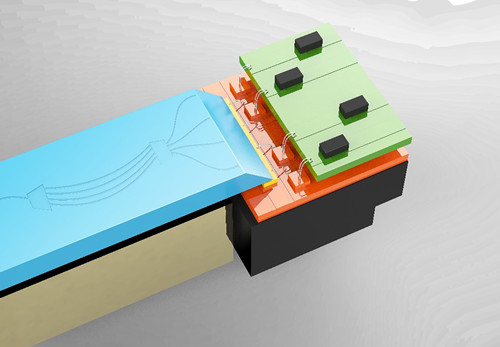With the rapid growth of the data traffic for hyper-scale internet data centre, the demand for high speed optical transceiver modules to interconnect among the intra and inter data centres beyond 100 Gbit/s becomes strong. Due to the limited space of the high port density line card data network center, the optical transceivers modules with small form factor are required to increase port density of line cards in communication systems. Considering the maturity of the process, the hybrid integration technology that assemble various discrete components in an ultra-compact tube is proposed to ensure the yield of the device.
For packaging process of receiver optical subassembly (ROSA) modules, the microwave circuit usually contains two parts of a radio frequency circuit and a bias network on which many capacitors and resistors are mounted. If they are all installed in one circuit board, it will easily cause crosstalk and distortion of the electrical signals. To overcome this drawback, the research group led by Dr. Jianguo Liu from Institute of Semiconductors, Chinese Academy of Sciences, proposed a 3D microwave circuit which allows radio frequency (RF) signal and bias voltage to be isolated in physical space for compact packaging. The value of this work is the experimental three-dimensional assembly of the ultra-compact ROSA based on the high speed microwave modeling. The -3 dB bandwidths of four channels of the fabricated module are all up to 20 GHz and the frequency response results are in very good agreement between the modeling and the experimental measurements. The results will extend our knowledge on hybrid-integrated technology. This work entitled Ultra-compact four-lane hybrid-integrated ROSA based on three-dimensional microwave circuit design has been published in Chinese Optics Letters, Vol. 17, Issue 3, 2019.
“The module used not only for 4×25 Gb/s non-return to zero (NRZ) modulation transmission, but also for many RF transmission systems such as remote antennas, satellite antennas, and secure encrypted communication. In addition, it can also be applied to radar systems to achieve full-band detection of radar”said Dr. Jianguo Liu from the research group.
With the multi-faceted application of detectors in radio-over-fiber (ROF) systems and digital center systems, detector modules will move toward high power output, high signal-to-noise ratio, miniaturization, integration, and low power consumption. The further work will focus on the integration of detector chips with other functional chips, such as semiconductor optical amplifier (SOA) chips, trans-impedance amplifier (TIA) chips, and development of multi-function devices.

The internal detailed configuration of the ROSA.


